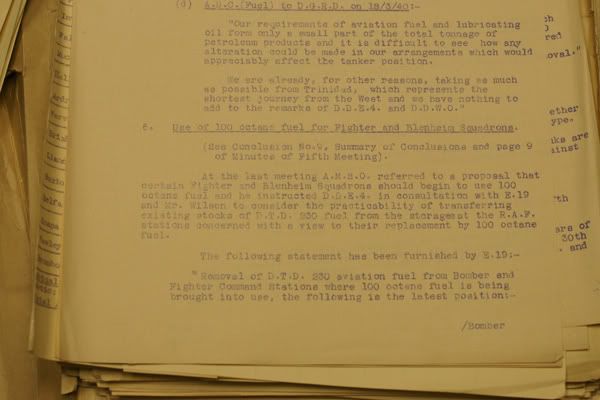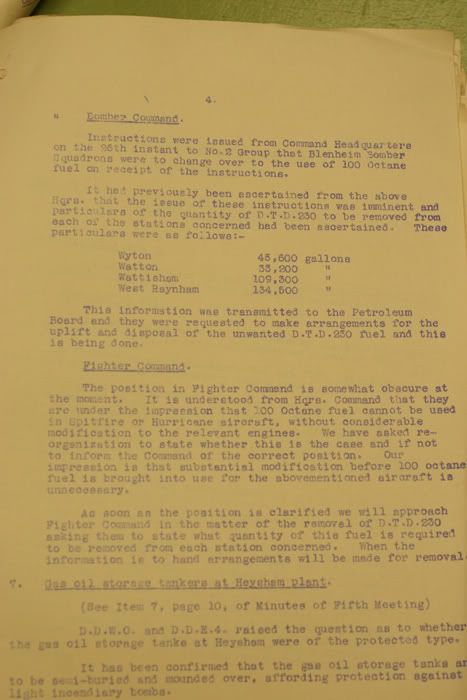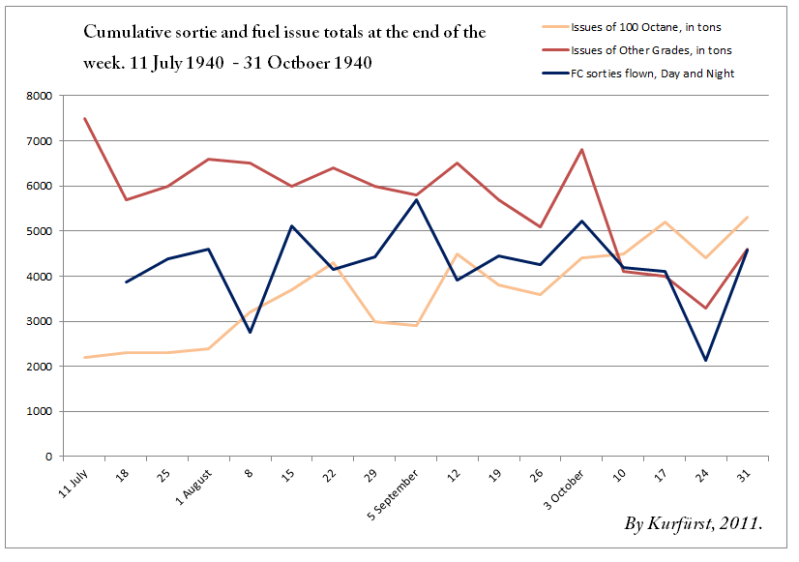
 |
|
#51
|
||||
|
||||
|
true,but it turned in an interesting debate.
thx for the book recommendation.i will buy it if i find it.i thought a lot of times about joining a squadron...may be its time to become a member of one. Last edited by David198502; 06-16-2011 at 02:30 PM. |
|
#52
|
|||
|
|||
|
[QUOTE=Blackdog_kt;297896]In terms of Bomber Command usage, the pilot's operating handbook for the Blenheim Mk.IV confirms the above points.
Actually, the Mk.IV used both types of fuel. What happened? 1) They needed more range so they added two more fuel tanks, one in each wing (the outboard tanks). 2) This made the aircraft heavier so it needed more power to get off the ground safely when fully bombed-up and fueled. 3) Engines were modified and a boost cut-out installed, so that maximum boost could raised from +5 lbs to +9 lbs. 4) This needed fuel with more resistance to detonation (aka 100 octane), but it was also important for Fighter Command use. So, what they did was load 100 octane only in the outboard tanks and use 87 octane in the inboard tanks. etc. etc. Hi, I generally agree. I've heard of Blenheims using 100 octane in the outer tanks only for boosting purposes (presumably take off with heavy loads as you say). I don't have the Blenheim manual, unfortunately - do you have link perhaps? OTOH, the documents supplied by Glider suggest that the actual modus operandi was to have select Blenheim stations at No. 2 Group (Wytton, Watton, Wattisham, West Rayam) receiving only 100 octane fuel, with 87 octane removed at the same time from the storage tanks. I suppose this was probably done to avoid nasty incidents of mistakenly filling tanks w. 87 octane - its rather unhealty to loose all power due to engine failuire in heavily bomb laden bomber on takeoff..   Given the above, I believe in practice these Blenheims concerned were fueled with 100 octane only. Quote:
__________________
Il-2Bugtracker: Feature #200: Missing 100 octane subtypes of Bf 109E and Bf 110C http://www.il2bugtracker.com/issues/200 Il-2Bugtracker: Bug #415: Spitfire Mk I, Ia, and Mk II: Stability and Control http://www.il2bugtracker.com/issues/415 Kurfürst - Your resource site on Bf 109 performance! http://kurfurst.org 
|
|
#53
|
|||
|
|||
|
Quote:
Quote:
__________________
Il-2Bugtracker: Feature #200: Missing 100 octane subtypes of Bf 109E and Bf 110C http://www.il2bugtracker.com/issues/200 Il-2Bugtracker: Bug #415: Spitfire Mk I, Ia, and Mk II: Stability and Control http://www.il2bugtracker.com/issues/415 Kurfürst - Your resource site on Bf 109 performance! http://kurfurst.org 
|
|
#54
|
||||
|
||||
|
Quote:
You people are still debating this? Where is the common sense? |
|
#55
|
|||
|
|||
|
Quote:
Flight activity of all kinds will increase with good weather. This is such a simple concept, that it will be instantly apparent to almost everyone.  The RAFFC flew 5700 sorties and the RAF issued about 4500 tons of 100 octane fuel during the 1st week of September. 5700 sorties at 75 gallons per sortie = 427500 gallons or 1374 tons (assuming every fighter does a dead stick landing with empty tanks, it only rises to 1650 tons). This leaves more than 3000 tons for use in RAFBC and all other assorted and sundry users, more than enough for every twin engined Merlin bomber and fighter to be using 100 octane fuel and still leave lots left over for use by RAFFC. |
|
#56
|
|||
|
|||
|
There is too much things that does not match
|
|
#57
|
|||
|
|||
|
Quote:
What i previously described amounts to "on takeoff and half of the cruise portion of the flight", which is half the fuel burn for the sortie. In other words, quite a lot of 100 octane fuel in case of long range sorties and as low as none at all in short range sorties (unless they were bending the rules and carrying a few minutes worth of it to get better WEP boost values in case of trouble, but that would be a negligible amount). In conclusion, if the Blenheims generated enough sorties at long ranges or were routinely tasked with loitering around a certain area on patrol duty (eg, U-boats, reconnaissance, etc), they could account for quite a lot of 100 octane use. If on the other hand they were mostly flying cross-Channel hops in nuisance raids, they would mostly burn 87 octane. Until someone can produce a relevant document that deals with the amount, type and range/duration of their sorties during the BoB the argument can swing either way |
|
#58
|
|||
|
|||
|
This might prove relevant:
"the Bomber Stations concerned was practically complete (these Stations are Wyton Watton, Wattisham, West Rayham)" http://www.ww2aircraft.net/forum/att...ng-minute-.jpg Quite clearly only four Bomber/Blenheim bases were 'concerned' with 100 octane fuel. If those four stations held all Blenheim Squadrons, your claim may be true, but somehow I doubt it. Wyton had two Blenheim Squadrons at the time: Nos. 15 and 40 "In December 1939, both Wyton squadrons were sent to France and Nos. 15 and 40 Squadrons returned from the Continent to Wyton, the first step in converting Battle squadrons to Blenheims. Both squadrons flew their first bombing raids from Wyton on May 10, 1940 against targets in the Low Countries. The Blenheims of No. 57 Squadron were based briefly at Wyton in June before going south, returning for two weeks the following month before flying north only to appear again at Wyton in late October. " Wattisham had also two, Nos. 107 and 110 Squadrons http://www.raf.mod.uk/bombercommand/s30.html http://www.raf.mod.uk/bombercommand/s106.html Watton also had two Blenheim Squadrons: Nos.21 and 82 Squadrons http://www.raf.mod.uk/bombercommand/s31.html West Rayham had only one Blenheim Squadron, No. 139, and possibly from June 1940 also no. 18 also operating. That's 7 or more like 8 Blenheim Squadrons on 100 octane. At that time there were 15 Bomber Command Sqns. operating Blenheim IVs. But this pretty much explains where 100 octane fuel went in such quantities - even those 8 Blenheim Squadrons were consuming a lot. Total tankage was 468 imp. gallons compared to 85 gallons on the Spit - a worth of about 45 Fighter Squadrons..
__________________
Il-2Bugtracker: Feature #200: Missing 100 octane subtypes of Bf 109E and Bf 110C http://www.il2bugtracker.com/issues/200 Il-2Bugtracker: Bug #415: Spitfire Mk I, Ia, and Mk II: Stability and Control http://www.il2bugtracker.com/issues/415 Kurfürst - Your resource site on Bf 109 performance! http://kurfurst.org 
|
|
#59
|
|||
|
|||
|
Quote:
468 gallons is with no bomb load Total internal fuel capacity was 280 imperial gallons, or less, when used as a bomber. Normal TO weight = 13500 lb and 14300lb max. Empty weight = 9790 lbs Bombs = 1000lb crew = 600 lbs oil = 200lb (28 gallons) fuel = 280 gals = 2016lb (468 gallons = 3370lb and 15300lb TO weight with 1000lb bomb load) ------------------------ = 13886lbs, when normal max was 13,500lbs and overload = 14,400lb 13500lb = ~230 gallons with a 1000lb bomb load. Most BofB Blenheim missions were tactical strikes into France or as fighters where even 230 gallons was far more than was required. |
|
#60
|
|||
|
|||
|
[QUOTE=Seadog;298133]We know that the RAF was using vast amounts of 100 octane fuel.
5-10 000 tons a month - out of 50 000 tons total per months or compared to about 90 000 tons per month consumed by the Luftwaffe is hardly 'vast amounts'. Its a tiny amount, even compared to 1940 overall or later RAF consumption. Bomber Command (at least 8 Squadrons of Blenheims for example), engine manufacturers for running ins and testing, Squadrons for non-operational flying and practice. One Squadron in August 1940 for example did Quote:
Of course I did. Ironically, just two posts above. Besides yo simply display the logical fellacy of the Invisible Pink Unicorn: you seem to believe that if you claim something, without being capable proving it, and if others don't prove you wrong, you are automatically right. Right? Well, its just utter nonsense. See: http://en.wikipedia.org/wiki/Invisible_Pink_Unicorn All Figther Command Aircraft were operating on 87 octane previously; in March 1939 a decision was made to convert sixteen fighter Squadrons to 100 octane by September 1940, and in around May 1940 it was noted that 'certain' fighter squadrons were to be supplied with 100 octane fuel. Certain, not all. Well its not too hard figure out what the other-than-certain Fighter Squadrons were still running on, my dear Watson?  Quote:
__________________
Il-2Bugtracker: Feature #200: Missing 100 octane subtypes of Bf 109E and Bf 110C http://www.il2bugtracker.com/issues/200 Il-2Bugtracker: Bug #415: Spitfire Mk I, Ia, and Mk II: Stability and Control http://www.il2bugtracker.com/issues/415 Kurfürst - Your resource site on Bf 109 performance! http://kurfurst.org 
|
 |
| Thread Tools | |
| Display Modes | |
|
|